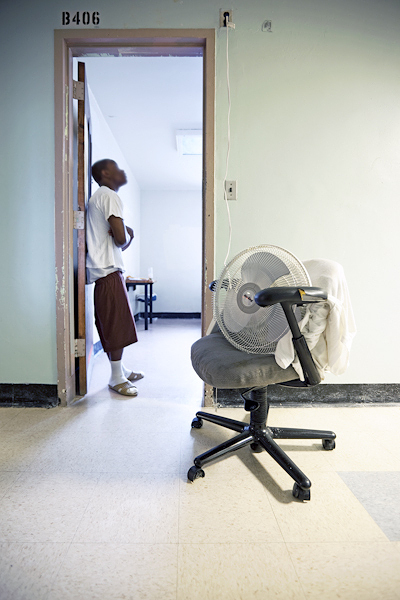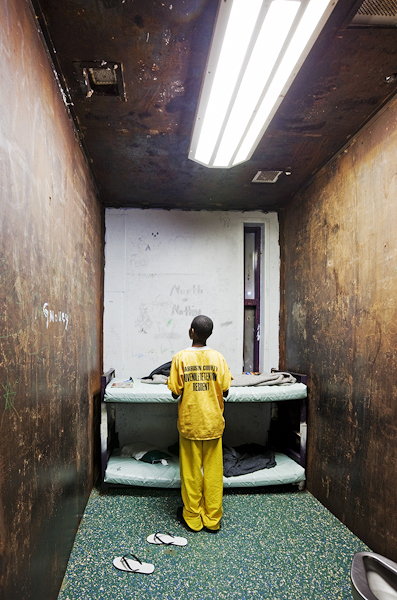I’ve been locked up for 21 months. I haven’t been sentenced yet. —D.P., age 16 Bridges Juvenile Center (Spofford), Bronx, New York, a secure detention facility built in 1957 with a maximum capacity of 75 kids, closed March 2011.
A 12-year-old juvenile in his windowless cell at Harrison County Juvenile Detention Center in Biloxi, Mississippi, operated by Mississippi Security Services, a private company. There is currently a lawsuit against MSS that forced it to reduce the center’s population. An 8:1 inmate to staff ratio must now be maintained.
The above images and text are from Richard Ross’ incredible “Juvenile In Justice” photography series, which was recently published in a book and currently on display in a touring gallery show.
This week we have Pete Brook visiting our class to join in the detention center workshop and present on his work back at PNCA. In honor of Pete’s work on prison photography (see more about that here), I wanted to post about photographer Richard Ross’ striking — and particularly relevant to our class — work in this field. Ross’ photographs observe and capture the stark, solitary moments of life in detention… the moments that even we who visit the facilities do not see. The moments of boredom, loneliness, and confinement that likely dominate the daily lives of these young people.
Ross describes the Juvenile In Justice project thus: “Juvenile In Justice is a project to document the placement and treatment of American juveniles housed by law in facilities that treat, confine, punish, assist and, occasionally, harm them.”
The New York Times wrote, in a review of his show at Ronald Feldman Fine Arts in New York City last winter:
The prisons in the photographs are often clean, plain, almost blank spaces, not all that different from contemporary art galleries and, it would seem, similarly conceived, though with different dynamics of power. The white-box gallery is intended as a timeless, cultureless space that gives forceful visibility to the art contained in it. The prisons are designed to throw figures of prisoners — in their Mondrian-red or yellow or black-striped uniforms — into sharp, surveillable relief and to disempower them through a kind of cultural neutralizing.
Breaking the pictures’ pristine look are the texts that accompany them, in which the young people photographed — all faces are obscured — speak of early abuse, material deprivation and emotional disturbance, realities that jail is likely to extend and exacerbate.
Conceptually, the show is a sobering trip down the dead-end street that is America’s prison system. Visually, it’s as gripping as any art around, and, in Mr. Ross’s book, comes with a memorable epigraph by Booker T. Washington: “The study of art that does not result in making the strong less willing to oppose the weak means little.”
I urge you to explore more of Richard Ross’ work at his website.
I’m doing my “seg time.” I spend all day and all night in here. No mattress, no sheets, and I get all my meals through this slot. — J., age 16, in a segregation cell in South Bend Juvenile Correctional Facility, South Bend, Indiana.



